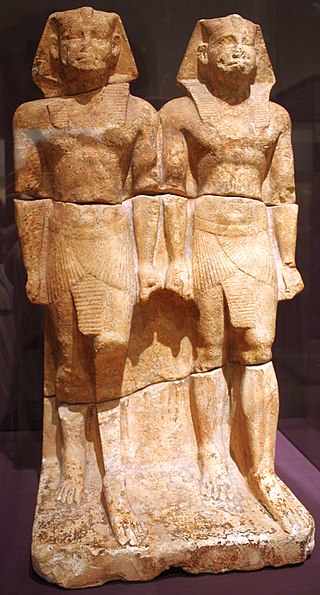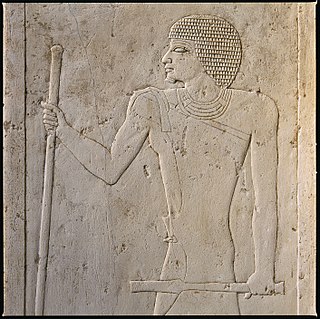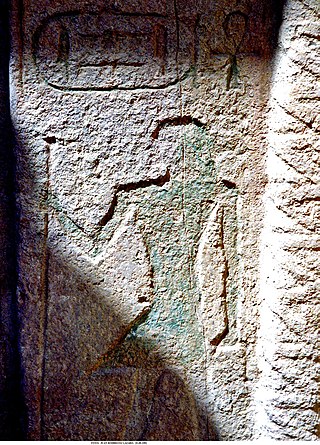
Huni was an ancient Egyptian king, the last pharaoh of the Third Dynasty of Egypt during the Old Kingdom period. Bases on the Turin king list, he is commonly credited with a reign of 24 years, ending c. 2613 BC.

Userkaf was a pharaoh of ancient Egypt and the founder of the Fifth Dynasty. He reigned for seven to eight years in the early 25th century BC, during the Old Kingdom period. He probably belonged to a branch of the Fourth Dynasty royal family, although his parentage is uncertain; he could have been the son of Khentkaus I. He had at least one daughter and very probably a son, Sahure, with his consort Neferhetepes. This son succeeded him as pharaoh.

Menkauhor Kaiu was an Ancient Egyptian pharaoh of the Old Kingdom period. He was the seventh ruler of the Fifth Dynasty at the end of the 25th century BC or early in the 24th century BC.

Djedkare Isesi was a pharaoh, the eighth and penultimate ruler of the Fifth Dynasty of Egypt in the late 25th century to mid-24th century BC, during the Old Kingdom. Djedkare succeeded Menkauhor Kaiu and was in turn succeeded by Unas. His relationship to both of these pharaohs remain uncertain, although it is often conjectured that Unas was Djedkare's son, owing to the smooth transition between the two.

Neferefre Isi was an ancient Egyptian pharaoh of the Fifth Dynasty during the Old Kingdom period. He was most likely the eldest son of pharaoh Neferirkare Kakai and queen Khentkaus II. He was known as prince Ranefer before he ascended to the throne.

Nyuserre Ini was an Ancient Egyptian pharaoh, the sixth ruler of the Fifth Dynasty during the Old Kingdom period. He is credited with a reign of 24 to 35 years depending on the scholar, and likely lived in the second half of the 25th century BCE. Nyuserre was the younger son of Neferirkare Kakai and queen Khentkaus II, and the brother of the short-lived king Neferefre. He may have succeeded his brother directly, as indicated by much later historical sources. Alternatively, Shepseskare may have reigned between the two as advocated by Miroslav Verner, albeit only for a few weeks or months at the most. The relation of Shepseskare with Neferefre and Nyuserre remains highly uncertain. Nyuserre was in turn succeeded by Menkauhor Kaiu, who could have been his nephew and a son of Neferefre.

Shepseskare or Shepseskara was an Ancient Egyptian pharaoh, the fourth or fifth ruler of the Fifth Dynasty during the Old Kingdom period. Shepseskare lived in the mid-25th century BC and was probably the owner of an unfinished pyramid in Abusir, which was abandoned after a few weeks of work in the earliest stages of its construction.

Nimaathap was an ancient Egyptian queen consort at the transition time from 2nd Dynasty to 3rd Dynasty. Nimaathap may have acted as regent for her son Djoser.

Neithhotep or Neith-hotep was an ancient Egyptian queen consort who lived and ruled during the early First Dynasty. She was once thought to be a male ruler: her outstandingly large mastaba and the royal serekh surrounding her name on several seal impressions previously led Egyptologists and historians to the erroneous belief that she might have been an unknown king. As the understanding of early Egyptian writings developed, scholars learned that Neithhotep was in fact a woman of extraordinary rank. She was subsequently considered to be the wife of unified Egypt's first pharaoh, Narmer, and the mother of Hor-Aha.

Henutsen is the name of an ancient Egyptian queen consort who lived during the 4th dynasty of the Old Kingdom Period. She was the second or third wife of pharaoh Khufu and most possibly buried at Giza.
Thamphthis is the hellenized name of an ancient Egyptian ruler (pharaoh) of the 4th Dynasty in the Old Kingdom, who may have ruled around 2500 BC under the name Djedefptah for between two and nine years. His original Egyptian name is lost, but it may have been Djedefptah or Ptahdjedef according to William C. Hayes. Thamphthis is one of the shadowy rulers of the Old Kingdom, since he is completely unattested in contemporary sources. For this reason, his historical figure is discussed intensely by historians and Egyptologists.

Meresankh II was a Queen of Egypt who lived during 4th Dynasty.

Raemka was an ancient Egyptian prince of the Fifth Dynasty. He was buried in tomb 80 in Saqqara and was possibly a son of Pharaoh Menkauhor Kaiu and Queen Meresankh IV.
Meresankh IV was an Ancient Egyptian queen believed to have lived during the Fifth Dynasty of the Old Kingdom. Her familial ties are the subject of ongoing speculation.

Isesi-ankh was an ancient Egyptian high official during the second half of the Fifth Dynasty, in the late 25th to mid 24th century BC. His name means "Isesi lives". He may have been a son of pharaoh Djedkare Isesi and queen Meresankh IV, although this is debated. Isesi-ankh probably lived during the reign of Djedkare Isesi and that of his successor Unas. He was buried in a mastaba tomb in north Saqqara, now ruined.
Reptynub was a Queen during the Fifth Dynasty of Egypt. She was the wife of King Nyuserre Ini. She was possibly a mother of Menkauhor Kaiu.
Nimaathap II was an Ancient Egyptian queen suggested to have lived during the Fifth Dynasty of the Old Kingdom of Egypt.
Kaemtjenent was an ancient Egyptian official under pharaoh Djedkare Isesi in the late Fifth Dynasty, during the Old Kingdom period.
Ptahhotep Desher was an Ancient Egyptian official at the end of the Fifth Dynasty, most likely in office under kings Menkauhor Kaiu and Djedkare Isesi. His main function was that of a vizier. This was the most important office in Ancient Egypt, second only to the king. Ptahhotep also held other titles, such as overseer of the six great houses, overseer of the scribes of the royal documents and overseer of all royal works. These are all important functions, often held by a vizier.
Nebunebty was an Ancient Egytpian queen who has been tentatively associated with the 5th Dynasty of the Old Kingdom. Her name translates as 'the gold of the Two Ladies', or 'golden are the Two Ladies'.













